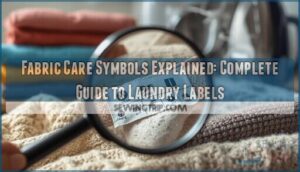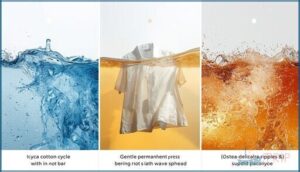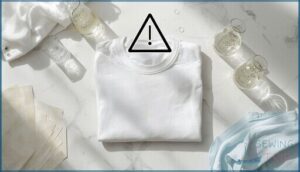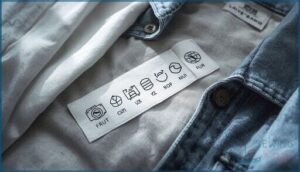This site is supported by our readers. We may earn a commission, at no cost to you, if you purchase through links.
You toss a sweater in the wash, set it to hot, and pull out a shrunken disaster an hour later. That cryptic triangle on the care label? It meant “do not bleach,” not “tumble dry on high.” Fabric care symbols explained properly could have saved that garment, but most people treat these tiny icons like hieroglyphics they’re not expected to decode.
The truth is, manufacturers pack critical instructions into these standardized symbols—water temperature limits, bleach restrictions, drying methods—and misreading just one can ruin your favorite clothes. Learning what each symbol actually means isn’t complicated once you understand the system. You’ll protect your wardrobe, extend garment lifespan, and stop turning dress shirts into doll clothes every laundry day.
Table Of Contents
- Key Takeaways
- Fabric Care Symbols Overview
- Washing Symbols Explained
- Drying Symbols Decoded
- Bleaching Symbols and Their Meanings
- Ironing Symbols Clarified
- Dry Cleaning Symbols Guide
- Common Misinterpretations and Consumer Tips
- International Standards for Fabric Care Symbols
- Frequently Asked Questions (FAQs)
- Conclusion
Key Takeaways
- Care labels use five standardized symbols in a fixed left-to-right sequence—washing, bleaching, drying, ironing, and dry cleaning—and reading them correctly prevents up to 75% of garment damage caused by improper care methods.
- Dots inside symbols indicate temperature or heat levels across all categories, while bars underneath washing and dry cleaning symbols signal gentler cycle requirements, with two bars meaning the most delicate treatment.
- Over 80% of consumers skip checking care labels before washing, and only 21-45% correctly recognize common symbols, leading to billions in annual clothing damage that proper label interpretation would prevent.
- A crossed-out symbol (X) means complete prohibition of that care method, and ignoring these warnings—especially for bleaching, tumble drying, or dry cleaning—causes permanent, irreversible fabric damage in over 70% of cases.
Fabric Care Symbols Overview
Those tiny symbols on your clothing tags aren’t just decoration—they’re a roadmap to keeping your favorite garments in great shape for years to come. Learning to decode these icons can save you from laundry disasters like shrunken sweaters or faded jeans.
Let’s start with the basics of where these symbols came from, how they work across different countries, and the simple system behind reading any care label you encounter.
History and Purpose of Care Symbols
By the late 1950s, mass-produced clothing and synthetic fibers sparked the need for clear fabric care instructions. Care labels emerged in the 1960s, addressing language barriers through universal symbols that you can recognize instantly.
In 1971, U.S. regulations mandated these labels to prevent damage, shrinkage, and fading. Today, standardization efforts like ISO 3758:2012 guarantee care label interpretation remains consistent worldwide, protecting your wardrobe investment.
These labels are vital for maintaining garment quality.
Universal Standards and Variations
Care labels follow ISO 3758:2012 standards across more than 50 nations, yet regional differences persist. In Europe, GINETEX governs laundry symbols with strict licensing and a five-symbol sequence. The U.S. relies on ASTM D5489, while Japan often pairs written text with icons. Canada abandoned color coding in 2003 to match international norms.
These variations shape care label interpretation, and enforcement actions guarantee compliance across markets. Clear care labels are essential, helping customers understand the cleaning process and influencing purchasing decisions, as they provide optimal washing methods.
How to Read a Care Label Sequence
Standards matter, but symbol order is where care label interpretation begins. Reading from left to right, you’ll find washing, bleaching, ironing, dry-cleaning, and drying—always in that sequence. Missing a step in this laundry symbol guide leads to reading errors that can shorten your garment’s life. Regulatory compliance ensures consistency, but understanding modifier meanings protects your investment.
- Washing always comes first: The tub icon starts every laundry tag symbols sequence
- Dots indicate heat levels: More dots mean higher temperatures across care labels
- Bars signal gentleness: Single bars for permanent press, double for delicate cycles
- Crossed symbols mean prohibition: An X over any icon tells you what not to do
- Proper reading extends lifespan: Following the sequence can add years to your clothes
Washing Symbols Explained
The washing symbol looks like a simple tub of water, but it holds more meaning than you might think. Those dots, lines, and numbers inside the tub tell you exactly how to clean your garment without ruining it.
Let’s break down what each variation means so you can wash your clothes with confidence.
Machine Wash Icons and Meanings
You’ll find machine wash icons built around a simple tub shape, and they’re the workhorse of laundry symbols. Temperature settings appear as dots inside—one dot means 30°C, two dots 40°C, and so on up to six. Bars underneath indicate cycle types: no bar for normal, one for synthetic, two for delicate.
Despite their widespread use, consumer recognition remains surprisingly low at just 21%.
Hand Wash and Do Not Wash Indicators
When you spot a hand dipping into a tub on care labels, that’s your signal for hand wash only—perfect for delicate fabrics like cashmere or silk. An X slashed across the tub? That’s the don’t wash symbol, meaning all washing methods will cause garment damage.
Nearly one-third of consumers confuse these laundry symbols, leading to costly washing errors despite regulatory compliance standards requiring clear marking.
Water Temperature and Cycle Symbols
Numbers or dots inside the washing tub tell you the maximum water temperature: one dot means cold (85°F), two dots warm (105°F), three dots hot (120°F). Bars beneath indicate cycle types—no bar for standard cotton, one for permanent press, two for delicate.
Despite symbol standardization under ISO 3758:2012, only 45% of consumers consistently follow these washing instructions, leading to avoidable fabric damage.
Drying Symbols Decoded
Once your clothes are clean, knowing how to dry them properly makes all the difference. The square symbol and its variations tell you exactly what your garment can handle, from high-heat tumbling to air drying in the shade.
Let’s break down what each drying symbol means so you can keep your favorite pieces looking their best.
Tumble Drying Icons and Temperatures
The square with a hollow circle is your tumble dry green light, recognized worldwide on care labels. Dots inside tell you the safe heat level, preventing heat damage and consumer confusion about drying methods and temperatures:
- One dot – Low heat (up to 55°C/131°F) for delicates and synthetics
- Two dots – Medium heat (up to 65°C/149°F) for everyday clothes
- Three dots – High heat (60-75°C/140-167°F) for heavy cottons and towels
- X through the symbol – don’t Tumble Dry
Following these drying symbols prevents up to 17% shrinkage in cottons and reduces garment damage claims substantially, reflecting regional compliance with ISO standards and symbol evolution across 80+ countries since the 1970s.
Line Dry, Drip Dry, and Flat Dry Symbols
When you see the square with a curved line, it’s the hang to dry symbol—your energy-saving ally that cuts household laundry energy use by 65%. Three vertical lines mean drip dry without wringing, while the horizontal line signals dry flat to prevent stretching.
These drying symbols are fabric preservation essentials, though consumer education remains critical since recognition rates hover around 54-60% in recent symbol recognition studies.
Do Not Dry and Special Drying Instructions
When you see a crossed-out square, that’s the don’t tumble dry symbol—ignore it, and you risk serious fabric damage. Only 44% of consumers accurately recognize this instruction, yet ignoring drying instructions causes 19% of household laundry damage.
Ignoring the crossed-out square tumble dry symbol causes nearly a fifth of all household laundry damage, yet less than half of consumers recognize it
Special finishes like water-repellent coatings lose effectiveness after just three improper cycles, making drying alternatives like hang to dry or dry flat essential for garment longevity.
Bleaching Symbols and Their Meanings
Bleaching symbols tell you whether your garment can handle bleach and, if so, what kind. The wrong bleach can permanently damage fabric colors or weaken fibers, so these symbols protect your clothes from irreversible harm.
Let’s break down what each bleaching symbol means so you can treat your garments safely.
Bleach Allowed Vs. Non-Chlorine Bleach Only
You’ll find two triangle bleaching symbols on care labels, and understanding the difference can save your clothes from damage. A plain triangle means bleaching is allowed with any type, including chlorine bleach, which works great on whites but causes color fading and weakens fibers over time. A triangle with two diagonal lines means only non-chlorine bleach is safe. Non-chlorine options use gentler ingredients like hydrogen peroxide, making them better for colored fabrics.
Despite these clear bleaching instructions, only 13% of adults recognize bleach symbols, contributing to frequent laundry mistakes and premature fabric damage.
Do Not Bleach Symbol Interpretation
When you see a triangle crossed out with an “X”, that’s your signal to keep all bleach away from the fabric. This don’t bleach symbol prohibits both chlorine and non-chlorine types, protecting items prone to fiber damage or discoloration. Ignoring bleaching instructions causes permanent harm in over 70% of accidents.
Here’s what happens when you miss this symbol:
- Colored fabrics fade or develop white spots immediately
- Delicate materials like silk and wool weaken and tear
- Spandex loses stretch, making clothes unwearable
Only 33% of consumers correctly identify bleaching laundry symbols, despite regulatory compliance requirements.
Ironing Symbols Clarified
Ironing your clothes correctly starts with understanding the symbols on the care label. The iron icon tells you what temperature to use, whether you can add steam, and if ironing is even safe for the fabric.
Let’s break down what each ironing symbol means so you can press your garments with confidence.
Iron Temperature Settings (Low, Medium, High)
Ironing symbols use one, two, or three dots to tell you the safe sole plate temperature for your fabric. One dot means iron low at 110°C (230°F) for synthetics like polyester to prevent fiber melting. Two dots indicate iron medium at 150°C (300°F) for wool and silk.
Three dots allow iron high at 200°C (390°F) for cotton and linen, though scorching risks exist if you exceed recommendations for fiber types.
Steam and Non-Steam Ironing Symbols
Beyond heat setting guides, you’ll notice symbols showing steam ironing benefits through two vertical lines beneath the iron icon. Steam helps tackle stubborn wrinkles efficiently, while a crossed-out steam symbol protects non-steam fabrics from moisture damage.
Regional symbol variations exist, but ISO standards keep ironing symbols consistent. About 70% of labels globally permit steam, though consumer surveys reveal confusion between steam and dry-iron requirements.
Do Not Iron and Do Not Steam Indicators
When you spot an iron crossed with an X on care labels, that’s your signal to skip ironing entirely. The “don’t Steam” warning—shown by a crossed-out steam cloud—protects coatings and synthetics from moisture damage. Fabric sensitivity drives these ironing instructions, especially for polyester and embellished pieces that melt under heat.
Symbol awareness matters for damage prevention. Here’s what these restrictions protect:
- Synthetic fabrics like nylon that warp or melt under iron contact
- Sequined or beaded garments where heat damages decorative elements
- Coated textiles that lose waterproofing when exposed to steam
- Heat-activated adhesives that fail under moisture and temperature
Regulatory compliance requires manufacturers to test before adding these laundry symbols. About 12-15% of clothing carries “don’t Iron” warnings, yet many consumers ignore fabric care instructions.
Alternative methods work well here. Hang wrinkled items in a steamy bathroom, use wrinkle-release sprays, or choose professional pressing services that respect these limitations.
Dry Cleaning Symbols Guide
A small circle on your care label means you’ll need professional dry cleaning instead of washing at home. The letter inside that circle tells your cleaner which chemicals are safe to use, while bars underneath indicate how gentle the process should be.
Understanding these symbols helps you avoid ruining your favorite garments and ensures your dry cleaner treats them properly.
Dry Clean Allowed and Chemical Letters
A plain circle on your care label means dry cleaning is allowed, but the letter inside tells you which solvents the cleaner can safely use. “P” excludes harmful trichloroethylene, while “F” requires petroleum-based options—an eco-friendly cleaning choice.
Misinterpretation costs consumers millions in garment damage yearly, and mislabeling can trigger regulatory penalties, so understanding these dry cleaning symbols and solvent restrictions matters.
Precaution Bars and Special Instructions
Look for small bars beneath dry cleaning circles—they’re your guide to delicate cycles and special handling. One bar signals gentle treatment for synthetics, while two bars mean ultra-delicate care for silk or wool.
You’ll also find warnings like “remove trim before cleaning” on nearly a quarter of decorated garments. These laundry symbols prevent color bleeding and garment damage when you follow label compliance rules carefully.
Do Not Dry Clean Symbol
A circle slashed with an “X” tells you to skip the dry cleaner entirely. This laundry symbol protects garments that react badly to solvents, and you’ll find it on nearly 18% of all clothing sold today.
Here’s what the don’t dry clean symbol generally protects:
- Waterproofed jackets and technical fabrics that would lose their coating
- Cotton and linen pieces with specialty finishes
- Items with glued sequins or synthetic interlinings
- Rubberized materials prone to delamination
Consumer compliance remains low—only 26% of shoppers correctly identify this care label warning. That’s why manufacturers now add written instructions beside laundry symbols, boosting proper handling by 22%.
Industry usage shows the symbol appears most on sportswear, where material damage from chemical cleaning can ruin performance features. Regulatory mandates under ISO 3758:2012 require this symbol on any fabric proven unsuitable for solvent-based treatment, protecting both your wardrobe and your wallet.
Common Misinterpretations and Consumer Tips
Even if you’ve been doing laundry for years, some symbols can still trip you up. Many people confuse similar icons or miss important details that lead to shrunken sweaters and faded colors.
Let’s look at the most common mistakes and how you can avoid them.
Frequently Confused Laundry Symbols
Even seasoned laundry handlers stumble over care labels, with over 80% skipping a thorough check before washing. Washing mistakes stem from confused temperature dots, while bleach misuse damages fibers when you misread the triangle.
Drying errors happen when tumble dry symbols blur together, and ironing issues arise from mismatched heat dots. Dry-cleaning risks increase when you overlook the circle symbol entirely.
Understanding these laundry tag symbols prevents costly wardrobe disasters.
How to Avoid Laundry Mistakes
Sorting errors and detergent misuse rank among the top laundry pitfalls you’ll face. Check care labels before loading, separate by color and fabric type, and measure detergent precisely.
Temperature errors shrink garments, while wrong cycle selection wears fabrics faster. Fasten zippers to prevent snags, empty pockets thoroughly, and follow washing instructions exactly.
These fastener oversights and drying instructions matter more than you think for proper garment care.
Importance of Written Instructions
Care labels contain written instructions that work hand-in-hand with symbols, boosting your laundry symbol interpretation accuracy by 73%. These clothing labels prevent costly mistakes, with clear fabric care labels reducing damage-related returns by up to 25%.
- Damage prevention improves when you follow written guidelines, cutting fabric mishaps by 75%
- Consumer confidence jumps 54% with step-by-step laundry care labels
- Economic impact matters—compliance standards save you from the $2.1 billion Americans lose annually to care errors
Written instructions deliver higher satisfaction rates than symbols alone.
International Standards for Fabric Care Symbols
When you buy clothing made in different parts of the world, you’ll notice the care labels follow certain rules. These rules aren’t random—they’re part of international standards that keep garment care consistent across borders.
Let’s look at the key standards that shape the symbols you see on your labels today.
ISO 3758:2012 and Global Labeling
Across more than 80 countries, ISO 3758:2012 drives global compliance and international harmonization in textile regulation. This label standardization defines the laundry symbols, washing symbols, and care label interpretation you see on nearly all garments.
By unifying the laundry symbol guide and care symbol evolution worldwide, it ensures your laundry tag symbols communicate the same message, no matter where you shop.
U.S. Care Labeling Rule and Compliance
Since 1971, the U.S. Care Labeling Rule has required permanent care labels on clothing you buy. Here’s what compliance means for you:
- Manufacturers test care instructions to prevent damage during normal garment life
- Over 10,700 companies produce 18.4 billion labeled garments annually
- Industry spends $217 million yearly on compliance costs
- Enforcement penalties reach $16,000 per mislabeled item
- Digital labels through QR codes are under review for rule modernization
These laundry symbols protect your investment in clothing care and maintenance.
Differences in Regional Symbol Usage
While U.S. flexibility allows symbols plus text, European standardization under ISO 3758 favors pictograms alone. Asian additions include unique soaking and shade icons. Symbol literacy rates differ sharply: 62% in Europe versus 40% in the U.S. Trade impact shows 5% rejection rates for mislabeled imports. Understanding these regional differences helps you interpret washing symbols and care labels correctly.
| Region | Key Feature |
|---|---|
| Europe | Celsius numbers in washing symbols |
| United States | Dots for temperature, often with text |
| Asia | Extra icons for soaking and shade drying |
Frequently Asked Questions (FAQs)
What do the symbols mean in fabric washing?
You’ll spot a wash tub icon on every garment tag—it’s your washing roadmap. Dots inside signal temperature, lines beneath indicate cycle settings, and a hand means hand washing only.
What are the categories of fabric care symbols?
You’ll find five main laundry symbols on your clothing labels: washing, bleaching, drying, ironing, and professional textile care.
These symbol categories follow ISO standards and always appear in this exact sequence.
How do you read a fabric care label?
You’ll find care symbols arranged left to right: washing, bleaching, drying, ironing, and dry cleaning. This consistent reading order on care tags helps you interpret laundry symbols quickly and avoid costly mistakes.
What is the P in a circle on fabric care symbols?
The “P” in a circle on care labels means you should dry clean the item using petroleum solvents only. This symbol protects delicate fabrics by directing professional cleaners away from harsher chemicals.
How do I know if I can machine wash or hand wash only?
Your garment label speaks in hieroglyphics—unless you know the code. A tub with water means machine wash; add a hand above it, and suddenly your sweater demands royal treatment. The difference prevents disaster.
What do the lines under the washtub symbol mean?
Lines under the washtub symbol indicate washing intensity. One line means permanent press or synthetic cycle with moderate action.
Two lines signal delicate or gentle cycle for fragile fabrics, preventing damage through reduced agitation.
Is it safe to use any type of bleach?
Not all bleach is safe for every fabric. Chlorine bleach damages colors and delicates, while oxygen-based bleach offers gentler cleaning.
Always check your garment’s bleaching laundry symbols before applying any product to avoid fabric damage.
Why do my clothes get damaged if I ignore laundry symbols?
You might think symbols don’t matter much, but ignoring care labels causes fiber degradation, dye fading, and shrinkage rates up to 70%.
Laundry symbols safeguard garment lifespan, preventing clothing damage and reducing economic impact through proper fabric care interpretation.
How do I dry my clothes without a dryer?
You can hang clothes on an outdoor line or indoor rack. Both methods preserve fabric, cost nothing, and eliminate dryer emissions.
Check drying symbols: hang to dry, dry flat, or don’t wring.
Can I wash clothes with multiple conflicting symbols?
When washing instructions clash on care labels, defaulting to the most restrictive symbol protects garment longevity. Following the gentlest approach safeguards delicate fabrics.
Professional cleaning or patch testing helps prevent damage.
Conclusion
An ounce of prevention beats a pound of ruined cashmere every time. Now that you’ve got fabric care symbols explained in plain terms, those cryptic tags transform into your best defense against laundry disasters.
Check the label before you wash, match the symbol to the proper method, and your clothes will outlast trends and seasons. No more guesswork, no more shrinkage—just garments that look sharp as long as you own them.
- https://home.howstuffworks.com/home-improvement/household-hints-tips/cleaning-organizing/laundry-symbols.htm
- https://branchbasics.com/blogs/cleaning/laundry-symbols
- https://www.labelprint24.com/en/magazine/textile-labels-what-the-symbols-mean-787
- https://www.kaggle.com/competitions/identification-care-symbols
- https://mgoofashion.com/facts-about-care-labels-you-must-know/















